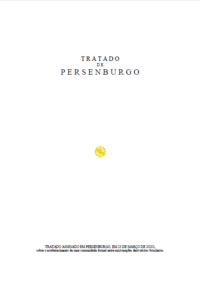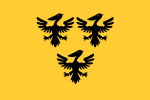Kingdom of Sildavia
This article uses a non-standard infobox to display information. Please transcribe the information to a standard infobox appropriate for the article. |
Reino da Sildávia (pt) | |||
| Constituent Country of the United Kingdom of Sildavia and Borduria | |||
| |||
| Motto: La couronne et mon droit The Crown and my right | |||
| Anthem:Salve vós, Rainha Maria | |||
| Capital | Klöw | ||
|---|---|---|---|
| Official language(s) | Portuguese | ||
| Demonym | Sildavian | ||
| Government | Absolute Monarchy Constituent Country of the United Kingdom of Sildavia and Borduria | ||
| - Monarch | Maria I | ||
| Formation | 11 March 2023 | ||
| Population | N/A | ||
| Currency | Hergerian Khor CS Doubloon | ||
| Date format | dd-mm-yyyy | ||
Sildavia, officially Kingdom of Sildavia (Portuguese: Reino da Sildávia), is a constituent country of the United Kingdom of Sildavia and Borduria. The capital and most populated city is Klöw. Portuguese is the national and official language. Being an absolute monarchy, the power of the state was concentrated in the head of state, Queen Maria I, with the Private Council as a form of advice to the sovereign in the governance of the kingdom. Founded on 01 March 2021, as a sildavian dominion, it was reorganized into a kingdom on 11 March 2023. In 11 March 2023 it was reorganized again to form the United Kingdom of Sildavia and Borduria.
Origins
Syldavia is named after the fictional country featured in The Adventures of Tintin, the comics series by the acclaimed Belgian cartoonist Hergé, and was depicted in King Ottokar's Sceptre (1938–1939), Destination Moon (1950), Explorers on the Moon (1952–1953, briefly), The Calculus Affair (1954–1956), and Tintin and the Lake of Sharks (1972), being also mentioned in Tintin and the Picaros (1975–1976).
According to Harry Thompson's 2011 Tintin: Hergé and Its Creation, Syldavia "was an idealised portrayal of central Europe between the wars – a benevolent monarchy, peaceful village life, sturdy peasants puffing on large pipes".[1] Herge himself has claimed that the country is heavily inspired by the real-world countries of both Albania and Montenegro. Sildavia is named after the work of Hergé, but it does not claim any fictional territory.
History
Foundation Era

The Principality of Sildavia was founded on 17 February 2020, declaring independence from Brazil, and initially claiming as territory what now comprised the city of Klöw, that since then served as the capital and of the then known as Orleans and Cocais Sub-regions. After a few months, Sildavia integrated all the other properties of the House of Sildavia into the territory of Sildavia.
Founded by Maria of Sildavia, by Royal Decree No. 01/2020, she assumed the title of Sovereign Princess of Sildavia. On 28 February 2020, the princess granted the first Sildavian constitution, which became known as the 2020 Sildavian Constitution or Primary Constitution, which established the principality as a constitutional monarchy. The Sovereign Princess sent the following message at the time:
I, with great pleasure and pride, grant and enforce this document. Showing that the Principality is governed by law and order.
— Maria I, Sovereign Princess of Sildavia.
After granting the constitution, the princess declared a period of regency in the country, with Prime Minister Lord Flaviano, who had the mission to organize the administration of the principality and ensure the effectiveness of the constitution. On 26 February 2020, Sildavia established its first bilateral recognition. During what is known as the March 2020 Decrees, Sildavia established their first symbols and decorations, among them the Sildavian National Anthem, the former national coat of arms, and the extinct Order of the Rose. On 28 March 2020, the first political parties in Sildavia were approved and created: the neoliberal Liberal Sildavian Party and the socialist Labor Party.
Consolidation

On 4 April 2020, Sildavia signed the Treaty of Persenburg and the Protocol of Goetha, and this diplomatic action introduced the micronation to the derivatist movement on micronationalism, avoiding the historical-modelist simulations that claimed to be micronations, so common in the so-called Lusophone sector. Through the treaty, Sildavia became one of the first micronations of the Brazilian sector and a fierce opponent of the simulationism. In this sense, Sildavia since then promotes derivatism and international cooperation, reason why Sildavia became a member of the Conference of Santiago with the Treaty of Santiago and developing an important role during the Santiago-Mansean Conflict, along Ebenthali and Lateran against Mansean aggressors.
After the resignation of the Prime Minister in May 2020, the leader of the Liberal Party, Countess of Almeida-Pereira took office. On 8 May, Sildavia ratified the Convention of Mauritsstad, regularizing relations between the micronations of the Conference of Santiago and virtualist micronations; and shortly after ratification, Sildavia and the United Provinces of Mauritia established diplomatic relations, a prestigious diplomatic victory to the Sildavian Government. Taking part in the promotion of the Brazilian sector abroad, by September 2020, Sildavia established the first mutual recognition with a micronation from another sector, the State of Vishwamitra.[2]
On 27 January 2021, the Sovereign Princess assumed all powers of the principality and on the following day, promulgated a new constitution[3] and started a period the national historiography calls "Marian Era". On 2 March 2021, by royal decree, the Sovereign Princess raised the principality to kingdom ruled by an absolute queen.[4]
Marian Era (Contemporary history)
After becoming a kingdom, Sildavia went through a process of reorganization, changing the symbology, administrative positions and also the administrative division. Firstly, changing the symbology, such as the national coat of arms, the flag and the anthem itself (which, despite changing the melody, kept the name). As the Monarch of Sildavia became absolute, it absorbed all the powers of the realm, including the administration of the Sub-regions, now renamed as provinces; however she appointed people to fulfill her administrative duty on her behalf in some specific provinces with her supervision. On April 9, the Queen in agreement with the then Gabriela, Countess of Almeida-Pereira founded a new state, the Grand Duchy of Mëcklewmburg-Wladir, becoming a constituent state of Sildavia, governed by a diarchy by the Queen and the Countess who became the Grand Duchess as well as the Queen.

On June 7, 2021 the Grand Duchess and the Queen began negotiations for the emancipation of the Grand Duchy as an independent state. Negotiations ended twenty days later on June 27 with the Treaty of Mëcklewmburg-Wladir. According to negotiations:
- The Queen would remain as Head of State of the Grand Duchy, would continue with the title of Grand Duchess, serving as adviser of state to the Head of Government.
- The Grand Duchess would act as head of state and maintain the integrity, independence and self-determination of the state.
- The two countries would now form a kind of International Organization to serve the interests of the participating countries, functioning as a political association that was called the Sildavian Commonwealth of Nations, until now composed of Sildavia, and the Grand Duchy.

On 1st September 2021, through Her Majesty's Royal Act N°01, the Queen declared the Imperial Dominion of Borduria to be founded. The fact was a milestone in the history of Sildavia, as after creation, the Queen became the Imperial Monarch of Borduria, being stylized within the Borduria as "Her Imperial and Royal Majesty the Queen-Czarina". Despite this, Borduria's creation was questioned for its "Imperial" status, as that status would in theory be above royal status, and in Sildavia it was considered reversed, being the royal title with higher status. The fact was compared to the British case, where the Monarchs of the United Kingdom were Emperors of India. On 23 December 2021, the Kingdom celebrated for the very first time the Queen's Day (Birthday of the Queen and a holiday within the country). On that month, the country has nominee its first diplomatic official to a neighbor country, The then Baron von Gänseblümchen, as Ambassador to Brazil.
At the beginning of 2022, Sildavia has achieved its first health milestone, having all resident citizens being vaccinated against Covid-19 and has signed a treaty of mutual recogniton with the Principality of Sancratosia. On April 2022 Sildavia became envolved in yet another episode of the series of diplomatic conflicts that extends from 2020 that the governments of the Brazilian Sector dubbed the Microlusophone Cold War, coordinating a diplomatic campaign against the Kingdom of Manso in retaliation for the smear campaign against the member states of and the Conference of Santiago itself carried out by the government of that country. On the following months, Sildavia has continued it's diplomatic work, firming relations with Raphania and the Republic of Upper Shwartz Morgen Lorgen Land.
Union with Borduria and Reorganization
In March 2023 the Queen issued an royal act creating a union between Sildavia and Borduria, creating the United Kingdom of Sildavia and Borduria.
National symbols
-
Flag of Sildavia
-
Lesser Coat of Arms
Geography
Sildavian lands are enclaved in the cities of Caeté and Belo Horizonte, all in the state of Minas Gerais, Brazil; close to the Tropic of Capricorn, where the shoreline is oriented east–west, and share land borders with Brazil and the Grand Duchy of Mëcklewmburg-Wladir. Its size, relief, climate, and natural resources make Sildavian geographically simple, with Atlantic forests and a Subtropical climate. With a total small area, Sildavia spans only one time zone, the UTC−3, and the summer time zone UTC−2.
Climate
The climate of Sildavia comprises temperatures average between 9 and 35 °C (48 and 95 °F). The Köppen climate classification of the region is tropical savanna climate (Aw), milder due to the elevation, with humid/warm summers and dry/mild winters. Sildavian is located about 500 kilometres (310 mi) from the sea.
Even though inter-seasonal differences are not as pronounced as they are in temperate places, there is a contrast between spring and summer, and between fall and winter. The coldest month is generally July, with a lowest recorded temperature of 2 °C (36 °F). The hottest month is usually January, with a highest recorded temperature of 38.4 °C (101 °F).
The 852-metre (2,795 ft) elevation of Sildavia helps a little in cooling the country, suppressing high maximum air temperatures experienced in nearby cities at lower altitudes. Sildavian climate is mild throughout the year. Temperatures vary between 11 and 31 °C (52 and 88 °F), the average being 22 °C (72 °F). Winter is dry and mostly sunny, and summer is rainy.
| Climate data for Sildavia | |||||||||||||
|---|---|---|---|---|---|---|---|---|---|---|---|---|---|
| Month | Jan | Feb | Mar | Apr | May | Jun | Jul | Aug | Sep | Oct | Nov | Dec | Year |
| Record high °C (°F) | 35.4 (95.7) |
35.2 (95.4) |
33.5 (92.3) |
32.7 (90.9) |
31.4 (88.5) |
30.5 (86.9) |
30.8 (87.4) |
33.8 (92.8) |
36.1 (97) |
38.4 (101.1) |
34.7 (94.5) |
34.8 (94.6) |
38.4 (101.1) |
| Average high °C (°F) | 28.4 (83.1) |
29.0 (84.2) |
28.5 (83.3) |
27.7 (81.9) |
25.8 (78.4) |
24.8 (76.6) |
24.7 (76.5) |
26.1 (79) |
27.4 (81.3) |
28.1 (82.6) |
27.7 (81.9) |
27.8 (82) |
27.2 (81) |
| Daily mean °C (°F) | 23.4 (74.1) |
23.8 (74.8) |
23.4 (74.1) |
22.5 (72.5) |
20.5 (68.9) |
19.3 (66.7) |
19.1 (66.4) |
20.3 (68.5) |
21.6 (70.9) |
22.6 (72.7) |
22.7 (72.9) |
22.9 (73.2) |
21.8 (71.2) |
| Average low °C (°F) | 19.8 (67.6) |
19.9 (67.8) |
19.7 (67.5) |
18.6 (65.5) |
16.4 (61.5) |
15.0 (59) |
14.7 (58.5) |
15.7 (60.3) |
17.1 (62.8) |
18.5 (65.3) |
18.9 (66) |
19.4 (66.9) |
17.8 (64) |
| Record low °C (°F) | 10.4 (50.7) |
12.8 (55) |
11.7 (53.1) |
8.8 (47.8) |
7.5 (45.5) |
3.1 (37.6) |
5.4 (41.7) |
7.2 (45) |
9.8 (49.6) |
11.4 (52.5) |
9.1 (48.4) |
13.5 (56.3) |
3.1 (37.6) |
| Average Precipitation mm (inches) | 329.1 (12.957) |
181.4 (7.142) |
198.0 (7.795) |
74.7 (2.941) |
28.1 (1.106) |
9.7 (0.382) |
7.9 (0.311) |
14.8 (0.583) |
55.5 (2.185) |
104.7 (4.122) |
239.8 (9.441) |
358.9 (14.13) |
1,602.6 (63.094) |
| Average relative humidity (%) | 73.0 | 70.0 | 71.4 | 69.2 | 67.4 | 66.2 | 62.4 | 57.8 | 60.4 | 64.1 | 70.5 | 74.0 | 67.2 |
| Average precipitation days (≥ 1.0 mm) | 16 | 11 | 11 | 6 | 3 | 1 | 1 | 2 | 4 | 8 | 14 | 18 | 95 |
| Sunshine hours | 176.0 | 190.8 | 194.9 | 210.7 | 221.2 | 229.9 | 240.5 | 241.5 | 202.5 | 196.5 | 166.9 | 153.3 | 2,424.7 |
| Source no. 1: Instituto Nacional de Meteorologia[5] | |||||||||||||
| Source no. 2: Meteo Climat (record highs and lows)[6] | |||||||||||||
Administrative regions
Sildavia is divided in two provinces, each of them governed by The Queen or someone designated by her personaly. The current provinces of Borduria are:
| Flag | Regions | Regions code |
Capital | Enclaved in | Governor | Official language(s) |
|---|---|---|---|---|---|---|

|
Klöw |
KLO | Klöw | Caeté | Queen Maria | Portuguese |

|
Dubronovk |
DNK | Dubronvk | Belo Horizonte | Queen Maria | Portuguese |
See also
References
- ↑ Thompson, Harry (2011). "King Ottokar's Sceptre". Tintin: Hergé and His Creation. John Murray Press. ISBN 9781848546738. https://www.google.com/books/edition/Tintin_Herg%C3%A9_and_His_Creation/a4s5AgAAQBAJ?hl=en&gbpv=1&dq=syldavia&pg=PT64&printsec=frontcover.
- ↑ "Bilateral Recognition between Sildavia and Vishwamitra", Secretaria de Imprensa da Sildavia, 23 September 2020.
- ↑ "Constitution of Sildavia", 28 January 2021.
- ↑ "Changes within the country", Secretaria de Imprensa da Sildavia, 5 March 2021.
- ↑ "Normais Climatológicas Do Brasil 1981–2010" (in português). Instituto Nacional de Meteorologia. Archived from the original on September 5, 2014. Retrieved 20 October 2018.
- ↑ "Station Belo Horizonte" (in français). Meteo Climat. Retrieved 20 October 2018.



